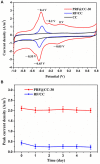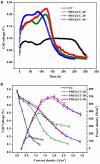Promoting Shewanella Bidirectional Extracellular Electron Transfer for Bioelectrocatalysis by Electropolymerized Riboflavin Interface on Carbon Electrode
- PMID: 30697199
- PMCID: PMC6340934
- DOI: 10.3389/fmicb.2018.03293
Promoting Shewanella Bidirectional Extracellular Electron Transfer for Bioelectrocatalysis by Electropolymerized Riboflavin Interface on Carbon Electrode
Abstract
The extracellular electron transfer (EET) that connects the intracellular metabolism of electroactive microorganisms to external electron donors/acceptors, is the foundation to develop diverse microbial electrochemical technologies. For a particular microbial electrochemical device, the surface chemical property of an employed electrode material plays a crucial role in the EET process owing to the direct and intimate biotic-abiotic interaction. The functional modification of an electrode surface with redox mediators has been proposed as an effectual approach to promote EET, but the underlying mechanism remains unclear. In this work, we investigated the enhancement of electrochemically polymerized riboflavin interface on the bidirectional EET of Shewanella putrefaciens CN32 for boosting bioelectrocatalytic ability. An optimal polyriboflavin functionalized carbon cloth electrode achieved about 4.3-fold output power density (∼707 mW/m2) in microbial fuel cells and 3.7-fold cathodic current density (∼0.78 A/m2) for fumarate reduction in three-electrode cells compared to the control, showing great increases in both outward and inward EET rates. Likewise, the improvement was observed for polyriboflavin-functionalized graphene electrodes. Through comparison between wild-type strain and outer-membrane cytochrome (MtrC/UndA) mutant, the significant improvements were suggested to be attributed to the fast interfacial electron exchange between the polyriboflavin interface with flexible electrochemical activity and good biocompatibility and the outer-membrane cytochromes of the Shewanella strain. This work not only provides an effective approach to boost microbial electrocatalysis for energy conversion, but also offers a new demonstration of broadening the applications of riboflavin-functionalized interface since the widespread contribution of riboflavin in various microbial EET pathways together with the facile electropolymerization approach.
Keywords: Shewanella; bioelectrocatalysis; electropolymerization; extracellular electron transfer; riboflavin.
Figures




Similar articles
-
Shewanella putrefaciens CN32 outer membrane cytochromes MtrC and UndA reduce electron shuttles to produce electricity in microbial fuel cells.Enzyme Microb Technol. 2018 Aug;115:23-28. doi: 10.1016/j.enzmictec.2018.04.005. Epub 2018 Apr 9. Enzyme Microb Technol. 2018. PMID: 29859599
-
Engineering Shewanella oneidensis-Carbon Felt Biohybrid Electrode Decorated with Bacterial Cellulose Aerogel-Electropolymerized Anthraquinone to Boost Energy and Chemicals Production.Adv Sci (Weinh). 2024 Oct;11(39):e2407599. doi: 10.1002/advs.202407599. Epub 2024 Aug 19. Adv Sci (Weinh). 2024. PMID: 39159306 Free PMC article.
-
Electromagnetic Field Drives the Bioelectrocatalysis of γ-Fe2O3-Coated Shewanella putrefaciens CN32 to Boost Extracellular Electron Transfer.Materials (Basel). 2024 Mar 26;17(7):1501. doi: 10.3390/ma17071501. Materials (Basel). 2024. PMID: 38612017 Free PMC article.
-
Mechanism and applications of bidirectional extracellular electron transfer of Shewanella.Environ Sci Process Impacts. 2023 Dec 13;25(12):1863-1877. doi: 10.1039/d3em00224a. Environ Sci Process Impacts. 2023. PMID: 37787043 Review.
-
Bidirectional extracellular electron transfers of electrode-biofilm: Mechanism and application.Bioresour Technol. 2019 Jan;271:439-448. doi: 10.1016/j.biortech.2018.09.133. Epub 2018 Sep 28. Bioresour Technol. 2019. PMID: 30292689 Review.
Cited by
-
Unraveling the multiple interactions between phages, microbes and flavor in the fermentation of strong-flavor Baijiu.Bioresour Bioprocess. 2025 Mar 5;12(1):14. doi: 10.1186/s40643-025-00852-1. Bioresour Bioprocess. 2025. PMID: 40042720 Free PMC article.
-
Transcriptome Analysis to Identify Crucial Genes for Reinforcing Flavins-Mediated Extracellular Electron Transfer in Shewanella oneidensis.Front Microbiol. 2022 Jun 1;13:852527. doi: 10.3389/fmicb.2022.852527. eCollection 2022. Front Microbiol. 2022. PMID: 35722328 Free PMC article.
-
Elongated Riboflavin-Producing Shewanella oneidensis in a Hybrid Biofilm Boosts Extracellular Electron Transfer.Adv Sci (Weinh). 2023 Mar;10(9):e2206622. doi: 10.1002/advs.202206622. Epub 2023 Jan 29. Adv Sci (Weinh). 2023. PMID: 36710254 Free PMC article.
-
Promotion of direct electron transfer between Shewanella putrefaciens CN32 and carbon fiber electrodes via in situ growth of α-Fe2O3 nanoarray.Front Microbiol. 2024 Jun 13;15:1407800. doi: 10.3389/fmicb.2024.1407800. eCollection 2024. Front Microbiol. 2024. PMID: 38939188 Free PMC article.
-
Carbon source priority and availability limit bidirectional electron transfer in freshwater mixed culture electrochemically active bacterial biofilms.Bioresour Bioprocess. 2023 Sep 20;10(1):64. doi: 10.1186/s40643-023-00685-w. Bioresour Bioprocess. 2023. PMID: 38647932 Free PMC article.
References
-
- Carmona-Martinez A. A., Harnisch F., Fitzgerald L. A., Biffinger J. C., Ringeisen B. R., Schröder U. (2011). Cyclic voltammetric analysis of the electron transfer of Shewanella oneidensis MR-1 and nanofilament and cytochrome knock-out mutants. Bioelectrochemistry 81 74–80. 10.1016/j.bioelechem.2011.02.006 - DOI - PubMed
-
- Celiesiute R., Radzevic A., Zukauskas A., Vaitekonis S., Pauliukaite R. (2017). A strategy to employ polymerised riboflavin in the development of electrochemical biosensors. Electroanalysis 29 2071–2082. 10.1002/elan.201700218 - DOI
-
- Chatterjee A., Foord J. S. (2009). Biological applications of diamond electrodes; electrochemical studies of riboflavin. Diam. Relat. Mater. 18 899–903. 10.1016/j.diamond.2009.02.016 - DOI
LinkOut - more resources
Full Text Sources

